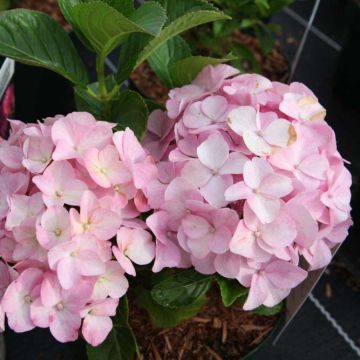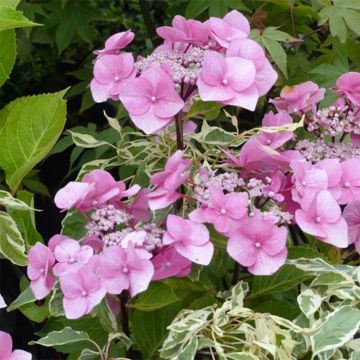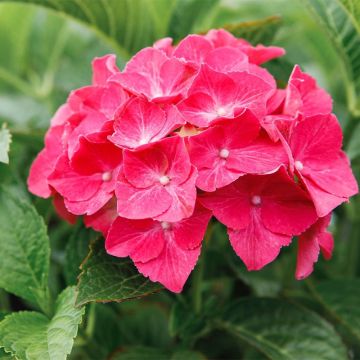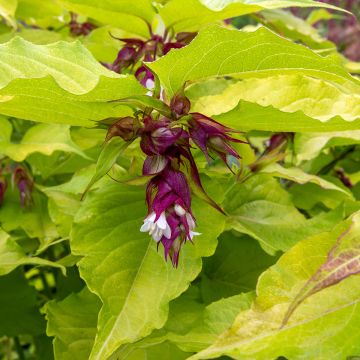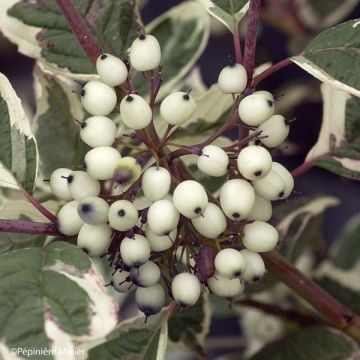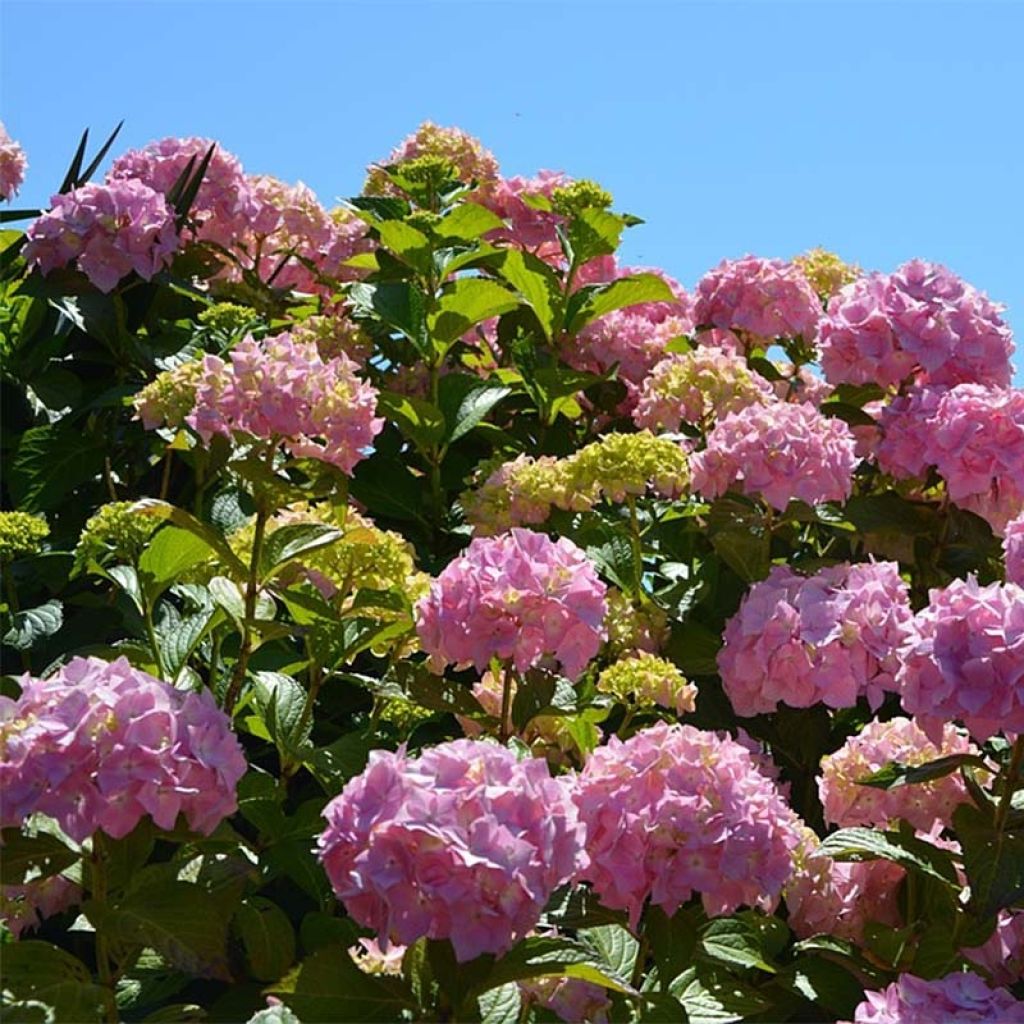

Hydrangea macrophylla Bouquet Rose
Hydrangea macrophylla Bouquet Rose
Hydrangea macrophylla Bouquet Rose
Bigleaf Hydrangea, French Hydrangea
This item cannot be shipped to the selected country
Delivery charge from €5.90
Delivery charge from €5.90
More information
Schedule delivery date,
and select date in basket
This plant carries a 24 months recovery warranty
More information
We guarantee the quality of our plants for a full growing cycle, and will replace at our expense any plant that fails to recover under normal climatic and planting conditions.
From €5.90 for pickup delivery and €6.90 for home delivery
Express home delivery from €8.90.
From €5.90 for pickup delivery and €6.90 for home delivery
Express home delivery from €8.90.
Does this plant fit my garden?
Set up your Plantfit profile →
Description
Hydrangea macrophylla 'Bouquet Rose' is an unusual, charming, perpetual and particularly cold-resistant variety of hydrangea. It owes its name to the arrangement of its inflorescences, which are made up of tightly packed pompoms in generous bouquets. Their colour depends on the nature of the soil: in neutral garden soil, its flowers range from cream-pink to mauve-pink, while in acidic soil, they will evolve from baby blue to bright lilac. At the end of summer, the thinner stems bend under the weight of the flowers in vintage tones, resting on foliage that has turned bronze, giving the shrub a wonderfully old-fashioned charm. Stunning in a romantic garden, you can also bring it into the home by making dried or fresh bouquets with its beautiful flowers.
'Bouquet Rose' is derived from the species H. macrophylla and H. serrata, among others. All these hardy plants belong to the Hydrangeaceae family and are native to China and Japan. 'Bouquet Rose' has a rounded and flexible habit, reaching about 1.2m (4ft) in all directions by the age of 10. Under good conditions, it can eventually reach a height of 2m (7ft), even 2.5m (8ft). The slightly weak branches tend to bend under the weight of the abundant flowering that begins in July on year-old branches. The flowering renews itself during the summer at the tips of the year's young shoots. Its inflorescences reach 15cm (6in) in diameter and are composed of several small clusters of sterile flowers packed tightly together. In acidic soil, the flowers will have bluer shades, while in neutral soil, they will be a slightly mauve pink. Their colour evolves as the flowers ripen. The flowering period extends over deciduous foliage that is a bright, matte green, which turns bronze as early as September and falls in autumn. The leaves are opposite, reaching a minimum length of about 15cm (6in). They are simple, elliptical, with a pointed tip and coarsely toothed like a saw. Hydrangeas can live for at least 50 years.
'Bouquet Rose', a classic feature of romantic flower beds, is a generous plant that has a strong impact both in the ground and in pots on terraces or balconies. It is well-suited to humid coastal gardens, as it withstands sea spray. Hydrangeas are well-known for brightening the north side of houses. This variety will thrive in an east or west-facing position that is not too hot, both in flower beds and hedges. Although these plants dislike chalky soil, hydrangeas are not strictly speaking acid-loving plants. Pair them with Magellan fuchsias, pieris, annual impatiens, or lilies, or plant spring-flowering bulbs and Omphalodes verna with forget-me-not-like flowers in front of their round silhouette. Enjoy their sumptuous flowering in the garden or in the house for a long time.
Report an error about the product description
Hydrangea macrophylla Bouquet Rose in pictures




Plant habit
Flowering
Foliage
Botanical data
Hydrangea
macrophylla
Bouquet Rose
Hydrangeaceae
Bigleaf Hydrangea, French Hydrangea
Cultivar or hybrid
Other Hydrangea Macrophylla
Planting and care
Plant in spring or early autumn, preferably in a slightly shaded position, for example against an east-facing wall, or even north-facing. In very cold regions, it may be prudent to protect its stump with a thick mulch. Protect it from cold and drying winds. It does not require ericaceous soil, but appreciates deep, moist but well-drained, fairly fertile soil, possibly enriched with a good base fertiliser before planting. If planting near a wall and the soil is dry at its base, place the root ball at least 30 to 40cm (12 to 16in) away from it and incorporate a quantity of well-decomposed compost to better retain moisture in the soil. Very hardy, it can be planted in cold regions without fear.
As for pruning, remove the faded flowers on the first bud or on the pair of buds directly below. When the plant is mature, prune the older stems back to the base by a quarter or a third. This will encourage the formation of young shoots. Carry out this pruning every year during March and April.
Planting period
Intended location
Care
This item has not been reviewed yet - be the first to leave a review about it.
Summer-flowering shrubs
Haven't found what you were looking for?
Hardiness is the lowest winter temperature a plant can endure without suffering serious damage or even dying. However, hardiness is affected by location (a sheltered area, such as a patio), protection (winter cover) and soil type (hardiness is improved by well-drained soil).

Photo Sharing Terms & Conditions
In order to encourage gardeners to interact and share their experiences, Promesse de fleurs offers various media enabling content to be uploaded onto its Site - in particular via the ‘Photo sharing’ module.
The User agrees to refrain from:
- Posting any content that is illegal, prejudicial, insulting, racist, inciteful to hatred, revisionist, contrary to public decency, that infringes on privacy or on the privacy rights of third parties, in particular the publicity rights of persons and goods, intellectual property rights, or the right to privacy.
- Submitting content on behalf of a third party;
- Impersonate the identity of a third party and/or publish any personal information about a third party;
In general, the User undertakes to refrain from any unethical behaviour.
All Content (in particular text, comments, files, images, photos, videos, creative works, etc.), which may be subject to property or intellectual property rights, image or other private rights, shall remain the property of the User, subject to the limited rights granted by the terms of the licence granted by Promesse de fleurs as stated below. Users are at liberty to publish or not to publish such Content on the Site, notably via the ‘Photo Sharing’ facility, and accept that this Content shall be made public and freely accessible, notably on the Internet.
Users further acknowledge, undertake to have ,and guarantee that they hold all necessary rights and permissions to publish such material on the Site, in particular with regard to the legislation in force pertaining to any privacy, property, intellectual property, image, or contractual rights, or rights of any other nature. By publishing such Content on the Site, Users acknowledge accepting full liability as publishers of the Content within the meaning of the law, and grant Promesse de fleurs, free of charge, an inclusive, worldwide licence for the said Content for the entire duration of its publication, including all reproduction, representation, up/downloading, displaying, performing, transmission, and storage rights.
Users also grant permission for their name to be linked to the Content and accept that this link may not always be made available.
By engaging in posting material, Users consent to their Content becoming automatically accessible on the Internet, in particular on other sites and/or blogs and/or web pages of the Promesse de fleurs site, including in particular social pages and the Promesse de fleurs catalogue.
Users may secure the removal of entrusted content free of charge by issuing a simple request via our contact form.
The flowering period indicated on our website applies to countries and regions located in USDA zone 8 (France, the United Kingdom, Ireland, the Netherlands, etc.)
It will vary according to where you live:
- In zones 9 to 10 (Italy, Spain, Greece, etc.), flowering will occur about 2 to 4 weeks earlier.
- In zones 6 to 7 (Germany, Poland, Slovenia, and lower mountainous regions), flowering will be delayed by 2 to 3 weeks.
- In zone 5 (Central Europe, Scandinavia), blooming will be delayed by 3 to 5 weeks.
In temperate climates, pruning of spring-flowering shrubs (forsythia, spireas, etc.) should be done just after flowering.
Pruning of summer-flowering shrubs (Indian Lilac, Perovskia, etc.) can be done in winter or spring.
In cold regions as well as with frost-sensitive plants, avoid pruning too early when severe frosts may still occur.
The planting period indicated on our website applies to countries and regions located in USDA zone 8 (France, United Kingdom, Ireland, Netherlands).
It will vary according to where you live:
- In Mediterranean zones (Marseille, Madrid, Milan, etc.), autumn and winter are the best planting periods.
- In continental zones (Strasbourg, Munich, Vienna, etc.), delay planting by 2 to 3 weeks in spring and bring it forward by 2 to 4 weeks in autumn.
- In mountainous regions (the Alps, Pyrenees, Carpathians, etc.), it is best to plant in late spring (May-June) or late summer (August-September).
The harvesting period indicated on our website applies to countries and regions in USDA zone 8 (France, England, Ireland, the Netherlands).
In colder areas (Scandinavia, Poland, Austria...) fruit and vegetable harvests are likely to be delayed by 3-4 weeks.
In warmer areas (Italy, Spain, Greece, etc.), harvesting will probably take place earlier, depending on weather conditions.
The sowing periods indicated on our website apply to countries and regions within USDA Zone 8 (France, UK, Ireland, Netherlands).
In colder areas (Scandinavia, Poland, Austria...), delay any outdoor sowing by 3-4 weeks, or sow under glass.
In warmer climes (Italy, Spain, Greece, etc.), bring outdoor sowing forward by a few weeks.

































